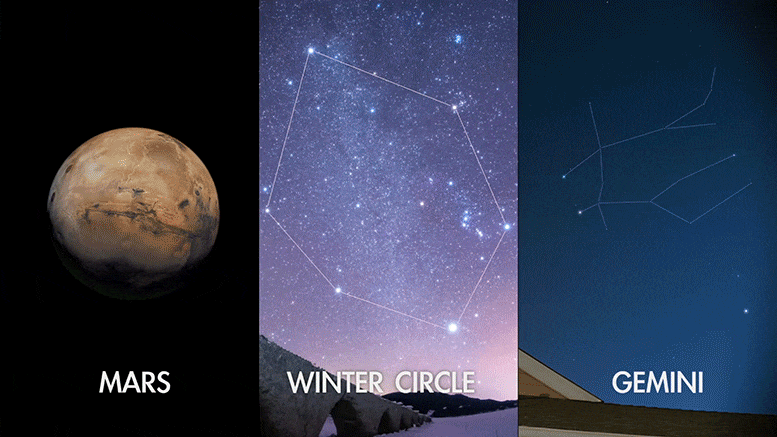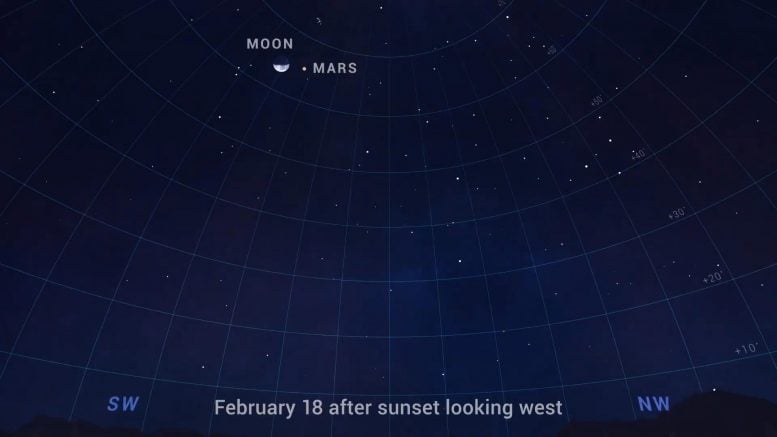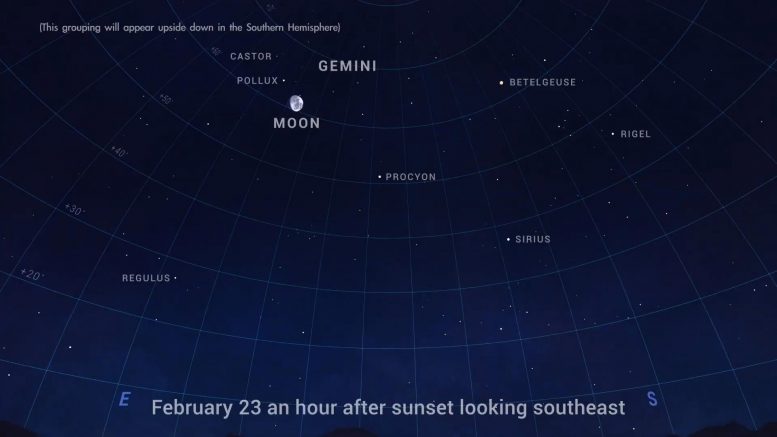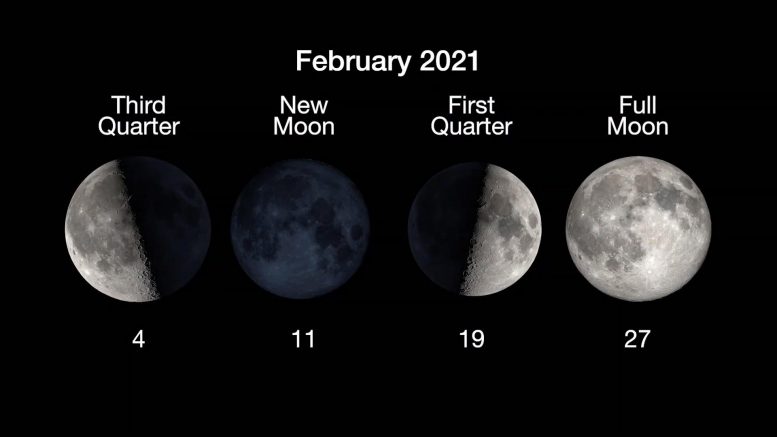
NASA skywatching tips February 2021
What are some skywatching highlights in February 2021? Find Mars all month after sunset, especially on the night of NASA’s planned rover landing, February 18. Then watch the Moon glide across the Winter Circle before it pays a visit to the bright stars of the constellation Gemini.
First up, excitement about the Red Planet is building as NASA prepares to land its latest rover there, called Perseverance, on February 18th. You’ll find Mars high in the west after sunset all month long. It should be visible all evening, setting around, or soon after, midnight local time.
On the night of NASA’s planned Mars landing, you’ll find the half-full Moon right next to the Red Planet. So go out and have a look with your own eyes – especially if you were one of the nearly 11 million people whose names traveled to Mars with Perseverance, etched into one of three microchips.

On the night of NASA’s planned Mars rover landing, find the Red Planet near the Moon in the west. Credit: NASA/JPL-Caltech
Staying with the Moon in February, it next drifts through part of the sky that contains a familiar pattern of stars, also called an asterism. This is the Winter Circle, or Winter Hexagon – a ring of six bright stars that spans a very wide region of the sky.
The Winter Circle contains two other special groupings of stars: the constellation Orion, and another wintertime asterism, the Winter Triangle, made of the bright stars Sirius, Betelgeuse, and Procyon. Like their counterpart, the Summer Triangle, the Winter Circle and Winter Triangle are signposts of the season. In the Northern Hemisphere, you’ll see them rising in the east early in the evening during the time of long, cold nights, and setting in the west earlier and earlier as the season turns to spring. Watch on February 20th through the 22nd, as the Moon moves across the Winter Circle, growing a bit fuller each evening.
Finally, the Moon continues on its journey, visiting the twins of Gemini. Unlike asterisms, Gemini is one of the 88 official constellations used by astronomers to help them describe the locations of objects in the sky. The two bright stars Castor and Pollux form the heads of the inseparable twins from Roman and Greek mythology for which the constellation is named.
On February evenings, Gemini is located high overhead in the south. On the 23rd the Moon is here, just below Pollux.
NASA also has a history with Gemini, as it was the name of the human spaceflight program in the 1960s that tested technology and capabilities in preparation for the Apollo missions to the Moon. But while the constellation is pronounced “JEM-in-eye,” not everyone knows the name of the NASA program was usually pronounced “JEM-ih-knee” within the space agency. However you want to pronounce it is fine. Just make sure you go out and catch the Moon’s visit with Gemini on the 23rd.
Here are the phases of the Moon for February. You can catch up on all of NASA’s missions to explore the solar system and beyond at nasa.gov. I’m Preston Dyches from NASA’s Jet Propulsion Laboratory, and that’s What’s Up for this month.
Daily Guide
February 4
Thursday midday, February 4, 2021, the waning Moon will appear half-full as it reaches its last quarter at 12:37 p.m. EST.
Sometime in the first half of February (2021-Feb-05 19:10 UTC with 6 days, 21 hours, 14 minutes uncertainty), Near-Earth Object (2018 CH2), between 22 to 49 feet (7 and 15 meters) across, will pass the Earth at between 1.3 and 30.2 lunar distances (nominally 14.5), traveling at 22,190 miles per hour (9.92 kilometers per second).
February 5
Friday evening, February 5, 2021, will be the last evening for this apparition that the planet Mercury will appear above the horizon 30 minutes after sunset (an approximation of when Mercury may still be visible in the glow of dusk).
February 6
On Saturday morning, February 6. 2021, the bright star Antares will appear to the lower right of the waning crescent Moon. The Moon will rise in the east-southeast at 2:41 a.m. EST, with Antares rising 22 minutes later. Morning twilight will begin around 6:10 a.m.
February 8
On Monday morning, February 8, 2021, the planet Mercury will pass between the Earth and the Sun, called inferior conjunction. Planets that orbit inside of the orbit of Earth can have two types of conjunctions with the Sun, inferior (when passing between the Earth and the Sun) and superior (when passing on the far side of the Sun as seen from the Earth). Mercury will be shifting from the evening sky to the morning sky and will begin emerging from the glow of dawn on the eastern horizon after about February 11, 2021 (depending upon viewing conditions).
February 11
Thursday afternoon, February 11, 2021, at 2:06 p.m. EST, will be the new Moon, when the Moon passes between the Earth and the Sun and will not be visible from the Earth. The day of, or the day after, the New Moon marks the start of the new month for most lunisolar calendars.
February 15
Beginning on or after Monday morning, February 15, 2021, the bright planet Jupiter will begin emerging from the glow of dawn, rising in the east-southeast about 30 minutes before sunrise.
February 16
Tuesday, February 16, 2021, will be Mardi Gras, also known as Shrove or Fat Tuesday, the traditional carnival on the last night before the 40 days of fasting for Lent. The date of Mardi Gras is loosely tied to the lunar cycle. Mardi Gras is 47 days before Easter, and Easter is generally tied to the first Sunday after the first full Moon of spring.
February 17
On Wednesday evening, February 17, 2021, sometime around 8:29 p.m. EST (2021-Feb-18 01:29 UTC with 1 hour, 45 minutes uncertainty), Near-Earth Object (2020 CX1), between 132 to 295 feet (40 and 90 meters) across, will pass the Earth at between 3.7 and 5.9 lunar distances (nominally 4.8), traveling at 18,510 miles per hour (8.27 kilometers per second).
February 18
Thursday morning, February 18, 2021, at 5:22 a.m. EST, the Moon will be at apogee, its farthest from the Earth for this orbit.
Also Thursday morning, Mercury and Saturn will begin appearing above the horizon in the east-southeast at the time morning twilight begins (at 5:57 a.m. EST), with Saturn appearing to the right of Mercury. Initially, Saturn will be the brighter of the two, but after a few mornings, Mercury will appear brighter than Saturn.
Thursday evening, Mars will appear to the upper right of the waxing crescent Moon. The Moon will appear 61 degrees above the southwestern horizon as evening twilight ends at 6:48 p.m. EST, and the Moon and Mars will set together in the west-northwest on Friday morning at 12:40 a.m.
February 19-20
On Friday afternoon, February 19, 2021, the Moon will appear half-full as it reaches its first quarter at 1:47 p.m. EST.
Friday evening into early Saturday morning, February 19 to 20, 2021, the bright star Aldebaran will appear near the half-lit Moon. Aldebaran will appear about 8 degrees to the left of the Moon as evening twilight ends at 6:49 p.m. EST and will appear to shift a degree or so closer by the time the Moon sets Saturday morning (at 1:39 a.m.). By Saturday evening the Moon will appear to have shifted to about 8 degrees to the other side of the Moon, and the pair will continue to separate after that.
February 21
Around Sunday morning, February 21, 2021, Mercury will begin appearing brighter than Saturn.
February 23
Tuesday morning, February 23, 2021, will be when Mercury and Saturn will appear at their closest together, just 4 degrees apart, low on the east-southeastern horizon (only 2 degrees above the horizon at the time morning twilight begins). After this, Mercury and Saturn will appear to separate, with Saturn continuing higher each morning while Mercury will appear to slow down, then begin to shift back towards the horizon each morning.
February 24
Heading into Wednesday morning, February 24, 2021, the bright star Pollux, one of the twins in the constellation Gemini, will appear near the waxing gibbous Moon. Pollux will appear about 4 degrees to the upper left of the Moon as evening twilight ends at 6:53 p.m. EST. The Moon will reach its highest in the sky for the night at 9:40 p.m. EST with Pollux appearing about 5 degrees above the Moon, and the Moon will set Wednesday morning at 5:19 a.m. EST with Pollux about 6 degrees to the right of the Moon.
February 26
Friday morning, February 26, 2021, the planet Mercury will appear at its highest above the horizon for this apparition at the time morning twilight begins, after which it will begin to shift back toward the horizon.
Friday evening, the full Moon will appear to the left of the bright star Regulus. As evening twilight ends at 6:56 p.m. EST, Regulus will appear about 7 degrees to the upper right of the full Moon, and the pair will appear to separate as the evening progresses.
February 27-28
The Moon will be full early Saturday morning, February 27, 2021, at 3:17 a.m. EST. The Moon will appear full for about three days through Sunday morning, February 28, 2021.











… a guide to that, just stick you eyes and that’s it… during the night…
hello this is very good, nice, and VERY COOL!!!!